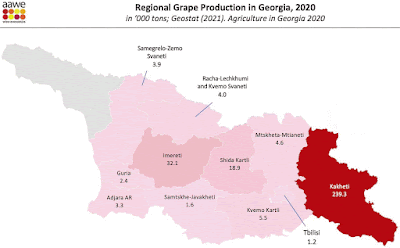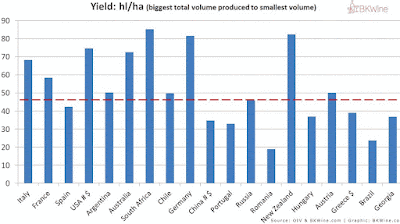The Georgian history is based on the dating of these 8,000 year-old earthenware vessels, called qvevri (or kvevri). The qvevri is Georgia’s best-known wine-making vessel, and it remains an important component of traditional wine-making in Georgia, even today. So, this finding of the remains of grapes and grape seeds in archaeological sites is the oldest evidence we currently have of wine production.
The 14th Annual Conference of the American Association of Wine Economists will be held in Tbilisi, Georgia, August 24–28, 2022. Obviously, this annual conference has not been held for the past 2 years; so it is somehow fitting to pick Georgia for a pandemic-ending restart. In this regard, I thought that it might be appropriate to compile, in one place, some of the current information about the wine industry in Georgia.
Wine-making is still an important business in Georgia, as it is the country’s fourth biggest export commodity. Wine exports contribute 6.5% to the national Gross Domestic Product (in terms of value), a greater percentage than for any other country (How much does wine contribute to total exports?). Somehow, this seems quite appropriate, for the place of origin.
As the homeland of wine-grape production, Georgia is reportedly home to roughly one-sixth of the world's total grape varieties, with more than 500 distinct indigenous varieties (Wine of Georgia: Georgian grape varieties). This does not mean, however, that most of them are used with any great frequency. Indeed, wine production is dominated by one main white variety: Rkatsiteli, with 53% of the vineyard area (47,997 recorded hectares). The following graph, from the AAWE, shows the vineyard hectares for the 21 most widespread varieties in 2016. Clearly, red wine is not a big thing in Georgia.
There are less than a dozen recognized grape-producing regions in Georgia, as shown in the following map, from the AAWE. One region dominates: Kakheti, in the south-east, as highlighted. Note that the region of Abkhazia (in the north-east) is grey, indicating no available data. Most countries recognize this region as an autonomous republic within Georgia; but it has been under Russian influence since the days of the Soviet Union, so that Georgia maintains merely an official government-in-exile.
If we look at the grape production figures for 2020, as shown in the next table (from the AAWE), we can see that the Kakheti region dominates both red and white grape production, with 69% and 78% of the national tons, respectively.
Production has increased in recent years, as shown in the next table (from the AAWE), with a 75% increase in tonnage over the 4 years. Moreover, Kakheti has maintained its dominance (c. 75% on the national tons).
This does not mean, however, that grape-vine yield is necessarily impressive. Indeed, the next graph (from BKwine) shows that Georgia has well below the average yield for wine-producing nations. The countries are in order (left to right) of decreasing total wine production (the dashed line is the average). To be economically effective, a country needs to have either big vineyard area or big yields — and clearly Georgia has neither (eg. Portugal has roughly the same yield, but much more area, and thus bigger production).
We could now look at where this wine goes to. A slowly increasing amount ends up in the USA, as shown in the next graph (from the AAWE). The value has increased nearly 7-fold across the 9 years, which is good for the Georgians. However, there has been a distinct preference for red wines, which is the minor component of Georgian production. This imbalance is being redressed, bit by bit.
So, where does the rest of the production go? A recent report makes the answer quite clear (Georgian wine industry seeks to reduce risk of Russian economic bullying):
The Georgian wine industry, gutted by a Russian embargo 15 years ago, is thriving once again. But success is resting on a shaky foundation. While exports reached record levels in 2021, roughly 55 percent went to Russia ...
The Georgian National Wine Agency reported 13.8 percent growth for wine export volume during 2021, with more than 100 million bottles distributed abroad by over 420 companies. Export revenue reached $239 million, a 5.6 percent jump over 2020. Most encouragingly for producers, exports increased significantly to the United Kingdom and United States, and broke into new Western markets, including Canada, Czechia and Sweden.
But the data still show that Georgian wine exports are stubbornly dependent on the Russian market. Among the top five nations that consume Georgian wines, Russia accounts for more than double the volume of the next four (Ukraine, Poland, China and Belarus) combined.Anyway, I presume that those people who make it to the AAWE conference will enjoy the local wines, first hand, even if they have never previously had any at home.
Valuable updates
There is a recent AAWE graph of Georgia's total wine exports 1996–2021 (value and volume).
Also, a recent AAWE graph of Georgia's wine export prices 2000–2021, by country.
Also, a recent AAWE graph of Georgia's wine exports 2020 and 2021, by country (value, volume and price).
Finally, recently noted is that Georgian wine exports to the U.S. have topped one million bottles.








No comments:
Post a Comment